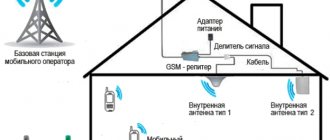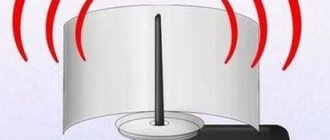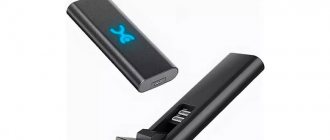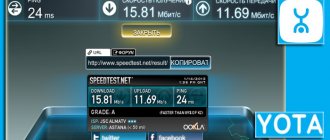The Yota company uses 4G communications using a high-frequency signal - the LTE standard. Long Term Evolution is a long-term development, based, in turn, on mobile network technologies such as GSM/EDGE, UMTS/HSPA.
This format allows you to achieve speeds (under favorable conditions) - 326.4 Mbit/s when downloading files, 172.8 Mbit/s when uploading. With a time delay during data transfer - 5 ms.
Such networks are most popular in small countries - South Korea, Japan, Kuwait. This is due to the main problem of this wireless protocol: base stations operate within a radius of about 6.8 km, given that the most popular bands used in Russia are LTE2600 and LTE1800 MHz.
In this regard, if difficulties arise with receiving/transmitting the Yota signal, you have to look for options to improve the signal. If simple methods (updating software, drivers, eliminating obstacles indoors, etc.) fail to solve the problems, then it may be necessary to use amplifying equipment - an antenna and a signal amplifier for Yota.
How to choose and not be deceived
The main parameter for antennas is gain. There is a special unit of measurement - isotropic decibel (dBi). So, if someone is trying to sell an antenna for Yota in the form of a small box and at the same time guarantees a gain of almost 80 dBi, then this is a clear deception. As an example, let's imagine an antenna with a small gain of 25-30 dBi with an operating range of 2500-2700 MHz, so its size will be almost 2x2 meters. The laws of physics are difficult to ignore.
Without going into details, we can say with confidence that among the available products there are no antennas that amplify the signal by more than 20-25 dBi. All proposals from “storytellers”-sellers about special signal amplification technologies are pure bluff. After all, the buyer will not be able to verify the veracity of these assurances, especially within the street market or online. Especially if he doesn’t understand the technical features of the amplification process well.
Therefore, it is best to choose products from reputable manufacturers through official websites or representative offices. Or in large online stores of the relevant profile.
If you spend some time online, you can choose Chinese models. In some cases, factory-made devices may turn out to be of quite decent quality. However, you should carefully study the reviews of specific users of these models (owners of Yota modems), but not on sites with recommendations, where you can stumble upon purchased (fake) reviews, but on thematic forums dedicated specifically to antennas for Yota.
It’s also worth mentioning the warranty period. When purchasing products on the market or on little-known store sites, the guarantee is very conditional. Problems may arise when purchasing online and on foreign Internet portals. It can be extremely difficult to prove anything. In the case when a product is purchased in a normal store, it is necessary to ensure that all documents are prepared properly: with dates, the signature of the sales consultant and the company’s seal.
Types of antenna devices
The HiTE PRO line of devices for Yota is offered by a popular manufacturer. The series includes both command and outdoor devices that support MIMO technology. These are universal models capable of operating in third and fourth generation networks. They are compact and amplify signals well. Some models are characterized by a gain of up to 24 dB. They are perfect for connecting the Internet to a country house.
Types of systems
Antennas and amplification kits for Yota can be divided into groups:
- Directional 4G panel antennas. It is possible to work in 3G mode if the 4G signal is too weak or absent. The gain factor (GC) is about 13-19.
- Antennas are parabolic. Gives good signal amplification, even if the base station is far away. One of the disadvantages is the price.
- Antennas are omnidirectional circular. A good universal type with a magnetic base. Provides average signal amplification, it is better to use when there is a signal from Yota, but is not stable. Can be used in cars.
- Indoor antennas. Connect to modems via a USB cable. The simplest option.
- Antennas for Yota with a modem or router. Good for those who are just planning to use Yota services, but have not yet purchased a modem. In this case, there is an opportunity to save a little, since the combi device will cost a little less than if purchased separately.
Antennas are configured, as a rule, automatically after connecting to a modem, or with minimal human intervention using the programs and drivers included with the antenna or amplification kit.
Some craftsmen make antennas for Yota themselves. Sometimes they even use satellite television dishes to boost the signal, connecting them to a modem and configuring them.
How to strengthen the signal of a Yota modem
Before amplifying the Yota signal, it is necessary to take measurements. This will make it possible to correctly establish a good reception area. To assess the signal stability indicator, you can use various services that providers often provide. It is advisable to conduct testing not only in a house or apartment, but also on the street. If you find that the signal is more stable outdoors, then the Yota amplifier will need to be installed outside. In this case, the device will need to be reliably protected from atmospheric agents. Despite the fact that modern manufacturers equip modems and routers with internal antennas, their power is usually not enough to fully amplify the signal. You can boost the signal using additional antennas, which are offered by many providers. Alternatively, you can assemble the Iota signal amplifier yourself.
Outdoor antenna-amplifier Yota 4G
If your home is located far enough from the nearest cellular operator base station, you should consider purchasing a special antenna from the operator. The amplifier is installed in the place where the most stable signal reception is observed. Purchasing a ready-made antenna for outdoor use is the most effective way to increase the Iota signal strength. Outdoor antennas are considered more powerful than indoor models. They are able to receive signals even from those towers that are located far from the user’s home. Model prices may vary. If you have any difficulties choosing a device, it is better to consult a specialist.
Wi-Fi signal repeater to expand coverage Iota
You can improve the signal reception quality of the Iota router several times in one simple way - extending the existing network. Routers have several channels, on which the physical and functional characteristics of reception can differ greatly. To change the channel, you need to log into the control panel of the device and select the channel on which a higher quality signal is observed.
Features of tower operation - directional LTE antennas
Without going into technical details, it’s easier to explain how the provider-client connection works.
First of all, you need to understand that it is the equipment of the Yota operator, mounted on the signal transmitting tower, that determines whether it is generally possible to ensure normal quality of communication with the subscriber and with what power the client’s modem/router should operate. One of the main parameters in these calculations is the estimated time. This is the maximum possible time with which a signal can travel from the Yota tower to the user’s device and return back.
In fact, for Russia, the distance between the Yota operator tower and the modem is up to 20 km. However, this is the maximum under ideal conditions. That is, when the tower is at a significant height, there is no interference in the signal path and the load on the operator’s equipment is minimal.
However, even if these conditions are met, the communication speed will be less than stated. Suppose Yota provides an output signal of 20 Mbit/s, the subscriber can receive a connection at this speed (±3-5 Mbit/s) only under ideal conditions at a distance to the modem no higher than 3 km from the operator’s transmitting antennas. Only the use of powerful kits such as MiMo will increase the distance to close to 20 km.
The use of powerful narrowly directional antennas for Yota (with a gain of more than 20 dBi) makes sense only if installation and configuration are carried out by specialists. Since the error in setting the angle is limited to 1-3 degrees, failure to fall within this range will result in either a ragged, unstable signal or its complete absence. This means that it is better to use simpler directional kits with a smaller gain, but with a larger installation angle (at least 35-40 degrees).
Fast Internet access anywhere
The Internet today has firmly entered almost all areas of life. It has gotten to the point that many people use it to make full-time money - if only they had access to the network! At first glance, it seems that there are no problems with the latter - in big cities it is possible from any mobile phone. But it’s not so simple everywhere! Unfortunately, in some holiday villages there are problems with the connection, and even the most powerful computer does not always help. But an Internet signal amplifier will solve the problem. Choosing it requires the right approach - buying such equipment on the market is a bad idea. You risk paying for a low-quality product. It is better to trust a specialized company that has a high reputation in the market. The best option is YS Service. We are a leading provider in Moscow and the region, and have confidently expanded into other regions. If you need an antenna for the Internet 4G, MIMO, LTE, 3G, it is difficult to find a better company to buy it from than YS Service. It has been proven that Iota equipment works flawlessly even in rural areas.
Features of a good antenna
The main thing is high-quality and stable signal amplification. At the same time, if possible, the product should not take up too much space or require constant manipulation to set it up or move it around the area of the apartment/house.
Electronic parts must be manufactured in accordance with current standards, this is important since some elements (capacitors, diodes, etc.) have a certain service life.
The quality of the complexes must be guaranteed by the manufacturer; it is advisable to have a support service capable of solving all difficulties that arise over the phone, online, or by calling a technician at home.
Is it worth taking a cheap one?
We will not consider antennas for Yota of the “no-name” class, purchased at the nearest flea market or on dubious Chinese sites. Because the vast majority of them soon end up in the trash heap. Some types are not even possible to repair, since upon opening it turns out that the board is flooded with something unknown, and the elements used are not marked.
Inexpensive factory-made devices are usually not designed for long-term use - this is due to the presence of budget materials and radio elements in the design. Therefore, if the signal amplifier will be used occasionally, not at full capacity, then it makes sense to buy a cheap complex, especially if there is simply no money for an expensive and high-quality device. However, even in this case, you need to be aware that the device may fail at the most inopportune moment.
If you plan to use it actively - with downloading large files, videos or the need for round-the-clock server support, then a cheap antenna complex may not cope with the task. The working board will overheat under load, and the amplification efficiency will disappear.
Antenna amplifier
You can make the antenna yourself. The base is a metal object. This is a metal or aluminum lid from a frying pan or pan where the modem is placed. The structure is fastened at the location where the maximum signal level is determined.
The signal amplifier for the Yota 4g modem can be represented by a satellite dish. A data transmission device protected from external influences is attached to it. It would be a good idea to point the modem in the direction where the nearest base station is located. It’s a good idea to get as much information as possible about this.
To learn how to make an antenna yourself, watch the video below.
Signal repeaters - repeaters
They work as reception stabilizers. The complex consists of a receiving antenna, which transmits it to a “repeater”, which transmits it to the internal antenna of the indoor modem, simultaneously clearing the signal from interference and, if possible, amplifying it.
Important! The receiving antenna included in the kit should be installed so that it covers as much space as possible, at the maximum height.
If the installation is carried out in a multi-story building, then repeaters should be located on each floor.
Such kits can operate in 2G mode for mobile communications, 3G and 4G for the Internet.
How to connect
As we discussed above, signal amplification is available to everyone. But to do this, you need to know how to connect the antenna to the Yota modem, and what instructions to follow. Let us immediately note that the use of an additional device is suitable for cases when the external modem has a USB connector. If you don’t have one, you can buy a device with a built-in mechanism or use a contactless option.
The general connection algorithm is as follows:
- Mount the antenna outdoors. Raise it as high as possible and, if possible, point it towards the tower. If you don't know its location, it's okay.
- Connect the device to the adapter included in the kit.
- Connect the modem and PC to each other using a USB extension cable.
- Install the Yota modem inside the adapter.
Detailed instructions on how to connect an external antenna to a yota modem should come with the equipment itself. As a rule, it provides step-by-step instructions, which simplifies the connection process. At the same time, even a beginner can understand the process.
Signal amplification using MIMO technology
Multiple Input Multiple Output (multiple input - multiple output).
Important! The basic principle of MIMO is the use of a set of antennas to receive and transmit signals separately. The point is that the receiving and transmitting flows do not interfere with each other, and the channel capacity (another important parameter of a network connection) increases.
Solutions based on this technology will provide reliable amplification, even if the Yota tower is located at a distance close to the maximum permissible. The gain factor for factory products is one of the largest in the line of devices available for non-professional use - up to 15-20 dBi.
However, it is worth considering that MIMO support for 3G networks is not very good, so 3G devices will work somewhat slower than Yota-supporting models
MIMO antennas are:
- Single-block - the whole complex is in one device, you just need to fix it in a place where the signal is well received.
- Spaced - they look like two antennas that are attached in the direction of the Yota operator tower. The difficulty is that installing such a complex correctly is difficult for a non-specialist, so you will have to carefully study the documentation or invite specialists from the company.
Another feature of MIMO kits is the need for a special optical cable and its proper connection to the modem/router. Poor installation will have a negative impact on the ability to amplify the signal; losses may occur as it moves along the cable.
What does it look like and what is it for?
Depending on the model, the antenna for Yota may have a round or rectangular shape with an installed modem (or without it), a connected wire or other elements included. Purpose - to strengthen 3G or 4G in places where there is low signal quality and, accordingly, poor connection quality. Using an antenna for Iota, the following problems can be solved:
- Great distance from the base station.
- There is a lot of interference.
- The location of the property is in an area with a large number of multi-storey buildings.
- Thick wall materials and a large number of partitions.
The use of the Iota antenna allows you to eliminate these difficulties and achieve the required communication speed. It is important to understand the types of such devices and correctly decide on the model. In this case, you can get the maximum effect.
Connection via contactless adapter
A contactless adapter is connected in cases where there is a good connection with the Yota provider on the street and you need to run a cable into the house.
The modem is placed in the adapter, an antenna cable is mounted to it (to the adapter), and a USB cord is mounted to the modem.
This method is also good because it allows you to connect almost any LTE antenna to a modem that does not have an antenna output. Without the need to open the device case and void the warranty.
This is one of the most inexpensive ways to improve the quality of Yota communications. However, this may reduce the Internet speed due to loss of part of the signal. That is, we will get a reliable signal without jumps, but at a lower speed.
Content
Fourth generation mobile networks have higher speeds compared to 3G. In LTE networks, services are provided by many cellular operators, including Yota. Despite the good quality of this operator’s network coverage and normal data transfer speeds, in some situations the need for strengthening becomes especially acute. An additional amplifier allows you to solve various difficulties associated with a poor, unstable signal. Today we will talk about what a Yota signal amplifier is and how it can improve the quality of signal transmission.
Antenna with built-in modem
These complexes consist of a modem/router and an antenna. They are a universal device. It should be purchased if the signal strength of a regular modem is absolutely not enough for comfortable work with Yota.
It is a device in the form of a block with connectors. Usually connected via USB to a computer or other device.
There are models of external units with two antennas that connect via LAN to a router or computer network card. These devices do not require separate power supply, since the PoE interface provides simultaneous transportation of both the signal and the supply current via a twisted pair cable. Moreover, it is permissible to use a wire up to 100 m long. Such solutions, although not the most budget-friendly, are quite effective and reliable. The only negative is their high cost.
Choosing antennas for Yota
The antenna for the Yota router must be correctly selected and connected correctly.
What nuances should you pay attention to when choosing a device:
- A good trap that functions well and has a coefficient of 20-30 dB will not be too small. Therefore, you should not choose miniature models.
- Antennas that can perfectly amplify the signal and operate in all bands will not be too cheap.
- It is advisable to buy antennas from well-known and trusted manufacturers that produce reliable products.
- Before purchasing, it would be useful to read customer reviews of this or that model of external antenna for the Yota modem.
Antenna modernization, soldering
If you have experience working with a soldering iron and need to improve the performance of the modem antenna, you can disassemble its case and, for example, install an external antenna instead of the built-in one.
Attention! If you disassemble the case, the existing warranty on the device from the manufacturer will be lost.
For soldering, it is recommended not to use conventional soldering irons of 60 W or more powerful, as there is a possibility of damage to “delicate” elements. It is best to use soldering stations or at least soldering irons no more powerful than 25 W.
Modernization with direct intervention in the structure will make sense if there is a clear understanding of the goal. For example, if you need to integrate an external antenna into a device without outputs for it.
Along with integrating an antenna into the modem, other problems also occur. For example, the Yota Connect-2.0 antenna, a popular device with many functions, categorically refuses to work with modems from other companies. Convenience lies in portability and special connection. The modem is not connected to the computer, but to the antenna itself. And from it - through a cable - to the computer. But a solution was still found. The antenna housing is disassembled and the Yota controller is carefully desoldered using a soldering iron. Now the complex will work with any modems.
Difficulties in manufacturing MIMO antennas
The main problem in the production of MIMO antennas is channel isolation. The higher the antenna gain, the more difficult it is to eliminate the influence of the circuits on each other. In order for the channel polarization to differ by exactly 90 degrees, it is necessary not only to correctly design the antenna, but also to very accurately maintain the geometry of its elements.
Therefore, when comparing 2 mimo antennas of the same gain, special attention should be paid to the noise level. An increased noise level will signal lower production quality, which will undoubtedly affect the stability and speed of the connection.
How to make it yourself
Craftsmen have come up with many designs for Yota that anyone can replicate; the effectiveness of these antennas varies and depends on the initial conditions (availability of the provider's transmitter, presence of interference, quality of source materials, modem brand).
Kharchenko's design
It is considered very successful. However, it is worth noting that the inventor created it for other purposes - to catch a signal from television programs in 1961!
Practical recommendations may vary; the base is thick copper wire. Its diameter is 3-5 mm. Sometimes kulibins use copper tubes, various strips, corners and profiles made of various materials, that is, everything that can be found in a home workshop.
Two squares are bent from the wire, after which both their tops need to be soldered together. We get a 2-diamond-shaped frame structure. To calculate the dimensions (depending on the frequency), use a calculator for the Kharchenko antenna, available on the Internet. The connection to the modem is made using a high-frequency cable, which is soldered to the center of the frame, the other side goes to the modem.
Attention! This design can be combined with a reflector (screen, reflector) to increase the efficiency of signal reception from Yota.
Simple can antenna
Many Yota subscribers claim that this type really works. The above design will require an aluminum can with a volume of 1 liter (other sizes can be used, determined by calculations).
The upper part must be cut off, and a rectangular hole must be made at a distance of approximately 40 mm from the bottom (if the cross-section of the existing Yota modem is a rectangle). These sizes are suitable for 4G, but you can use a virtual calculator for can antennas.
Reflector design
Here you will need a mesh MMDS reflector, a rod for it and fasteners. The tip of the mounting tube-rod is adjusted to the shape of the modem. Next, saw off the tube so that the tip of the modem is at the focus of the parabola - approximately 41 cm. A USB extension cable (no longer than 3 m) should be laid through the pipe, and the modem should be covered with a plastic jar as follows: attach the lid of the jar with a pre-drilled hole along the diameter of the pipe to rod (for example, with electrical tape), and screw the plastic jar itself onto the lid. We screw an unnecessary CD to the bottom of the bottle as a reflector.
All that remains is to properly secure the device in the most convenient place and connect it to the modem. Some testers managed to catch the signal from Yota transmitters reflected from neighboring buildings.
Factors that affect speed
The speed of the Internet connection of the yota 4g modem is influenced by factors such as:
- Degree of network congestion;
- Location of the modem in the room;
- Distance to the nearest tower;
- Design features of walls and partitions located in the signal path;
- The presence of various obstacles outside the building in the signal path: forests, buildings, uneven terrain;
- Location of nearby interference sources: high-voltage power lines, transformers.
Typical mistakes when assembling systems - correct installation of cables
The most common errors that greatly reduce the quality of Yota’s Internet connection include:
- Use of low-quality connecting devices - pigtails when laying the cable to the modem. There are a lot of Chinese adapters of disgusting quality, but with an attractive price (100-200 rubles).
- Excessively long cables and an abundance of connections and even twists on the modem-antenna line.
- During installation, the number of connecting elements must be minimized. The length of the cables is another factor that negatively affects the speed of communication with Yota. It is interesting that under certain conditions of incorrect assembly, you may not get an increase in the signal from Yota, but, on the contrary, a weakening of it, which will make the entire installation and waste of money pointless.
- Use of chrome contacts.
- For Yota, it is imperative to use contacts coated with beryllium bronze. Even high-quality assemblies with other types of contacts will begin to overheat after some time of operation, and at the same time a drop in power will be observed. Sometimes an effect may occur in which downloading occurs at normal speed, but the upload speed of files (Upload) will drop.
- Installing the “correct” bronze connections with chrome contacts will lead to a mismatch along the antenna-cable line (SWR parameter - standing wave ratio) - again: the modem will start to heat up, and the Internet will slow down.
- Chrome connectors are used only for operation at frequencies of 450 MHz. Yota uses much higher frequencies.
- Leaky assembly of devices placed outdoors or non-compliance of rubber seals with special standards; in other words, cheap rubber seals dry out over time, lose their shape and crack due to changes in temperature and humidity; liquid gets inside the device. This happens most often when the warranty period has already expired, and the manufacturer will not be responsible for a suddenly “dead” device.
- The antenna housing is not filled. As practice shows, hollow antennas operate much less than filled ones. Condensation will not form inside, parts will not be damaged by excess moisture.
- Poor soldering quality. It is quite problematic to manually ensure the necessary stability when soldering pigtails; their different resistances again have a negative impact on communication with Yota.
Types of antennas and advantages of their use
The Yota operator guarantees users the availability of high-speed 4G Internet. Providing this service is the general mission of the company. As technical support, the company offers subscribers 4G modems, routers and antennas for Yota.
Each type of antenna has characteristic properties and has a number of advantages during use. Below is a general classification of industrial, that is, those produced in streaming mode, antennas.
- Panel MIMO (that is, containing two amplifiers in one housing) 3G/4G directional antenna. The most popular in this category are various models of the Delta Station 3G/4G broadband dual-polarization antenna. Equipped with the function of automatically switching to a 3G signal in a situation where there is no 4G. Some modifications are designed to operate in two frequency ranges.
- Parabolic. Such models provide maximum gain and are ideal for use at significant distances from the base, as well as in places where there is a complete absence of signal. The only drawback of parabolic antennas is their high price.
- Circular omnidirectional. The main advantage of such products is their mobility. They are easy to install, have a magnetic base, and can be installed anywhere convenient, even in the car. The amplification power of the device is low, so they are used mainly to achieve stability of the Internet signal.
- Indoor antenna. Boosts the signal when connected to a receiving device via a USB cable.
- Antennas with a built-in modem or Yota router. Such models can be purchased if this device has not already been purchased separately. They are not suitable for boosting the signal of an existing modem or router.
If you have not yet purchased equipment to provide access to the Internet, but are only considering possible options, then purchasing a universal device is the ideal solution.
HiTE PRO antennas for Yota
These 4G antennas have a built-in modem and support signal reception from all cellular operators. To work, you must insert a proper SIM card into the device. The HiTE PRO antenna for Yota replaces the equipment kit for amplifying the radio frequency pulse.
Such systems are considered to be the most efficient, since the modem is already built into the antenna, and there is no signal loss on adapters and cables. Such an antenna for Yota can increase the speed of traffic exchange on the Internet tenfold, and you can install and configure it yourself, without contacting a specialist. If you already have a separate modem, the need for it disappears.
Using a satellite dish
To strengthen and stabilize the Internet signal, you can use a satellite dish. It is advisable to place it in a plastic container and attach it to the converter. The device is connected to the computer via a USB cable. This solution is especially effective for use in the region, in villages, suburbs and other settlements remote from towers.
The best possible gain is provided by a parabolic antenna with a mesh reflector, however, it is quite difficult to find these on sale, since they were no longer produced due to outdated standards.
The amplification efficiency may vary depending on the dimensions of the dish. For a high-quality connection at a distance of up to ten kilometers from the tower, a dish with a diameter of one meter is enough.
How to connect an external antenna to a Yota modem
An external antenna for amplifying 4G Internet from Yota is easy to install and configure. It is important to adhere to the following rules:
- point the antenna lower than when tuning to a television satellite;
- monitor connection quality using the Yota computer program;
- it is necessary to fix the antenna in the direction of the point of best signal reception;
- install the modem so that the USB port is at the end opposite the antenna;
- in case of constant interruption of the signal, the structure should be raised higher.
It is impossible to simultaneously use an antenna to receive a TV signal and amplify the Internet.











